


A research exhibition and live programme collated by
Rae-Yen Song 宋瑞渊
24 February — 18 May 2024
Tues — Sat, 11am — 6pm




A research exhibition and live programme collated by
24 February — 18 May 2024
Tues — Sat, 11am — 6pm
We spoke with artist, Rae-Yen Song 宋瑞渊, about the process of collating this exhibition, the themes they seek to explore, and the new possibilities this kind of exhibition programme holds.
This show is a “research exhibition,” can you tell us a little about that process, and how it has shaped what our audiences will see in the space?
Coming into this project a year and a half ago, I felt I was at a shifting point in my practice - a porous space full of questions and desires to dig deeper into personal fragmented ancestral memories that have ultimately affected my existence, and make me curious about other ways of living. I’m interested in ways of living that jettison colonial, patriarchal logics and power structures, and instead find resistance in more-than-human politics and multispecies interdependency, spiritual imaginations, and speculative worlding. In order to explore this porous space, I felt the urge to connect and learn from others - to nourish these lively thoughts and begin a dialogue that would further fabulate them in unexpected and experimental ways.
The way I think and research is grounded in a trusting of intuitive knowledge - a feeling into things - and so, I began with drawing. The plotting
of these dreams and imaginings turned into (T_T), a map~blueprint~dream that I used as a tool of connection and conversation. It was a way for me to approach and begin sharing my entangled thoughts with thinkers across many different disciplines. Perhaps nervous that I didn’t have an academic tongue or brain, I used (T_T) as a way to explore my own language - one that I could share with others in order for them to navigate and pick at ideas with me in more visual, sensual, imaginative ways.
I wanted the exhibition spaces to hold these ideas of searching and shared speculations… for the audience to navigate and experience such thoughts, materialities and growths through the entanglement of experiments, models, prototypes, speculations, events, documents, artefacts, artworks, expanded researches… All of this matter has settled as a testing-ground; a new culture of thought for me to learn from, and to inspire further thinking towards the following cycle, a solo exhibition at Tramway in 2025.
How does the exhibition relate to the concepts of ecology and growing?
With (T_T) as an open-ended thinking-drawing that resembles a floating beast, the concepts of this organism’s ecology and the ways in which it grows have been fundamental to this project, and symbolic of how the research exhibition and live programme exists.
In collating the work of over twenty artists and thinkers, I’m interested in an array of thoughts~particles becoming entangled to create an ecosystem of ideas - based on feminist and decolonial thinking, and ideas of ecological power and more-than-human politics. This ecosystem is one which I imagine growing beyond my limited conceptions of time and space, and in which I like to imagine alternative, hopeful modes of existence. Ecology and growth are important aspects of the new installation that I have created in the space, ○ squigoda song cycle ● water~land~air ○, which I see as an experiment in multispecies collaboration. It incorporates a pool of tea fungus which is connected to contact mics, a hydrophone and other sensors. Sonic inputs - such as those caused by the movements of viewers - pass through it; and as it slowly ferments, the tea fungus itself generates changing signals and audio inputs. These inputs all feed into three ever-changing live soundscapes that flow through the three exhibition realms: water, land, and air. This becomes a collaboration not only with human sound artist Tommy Perman, but with the tea fungus itself.
The work actively embraces continuous change, and establishes a creative relationship between me and other organisms, which I hope will develop and grow well beyond the duration of the exhibition.
The exhibition raises many questions for me: how do I want to affect my environment? How do I want to be part of it/inhabit it? How do I collaborate with others (human and beyond human) to exist and grow together, harmoniously?
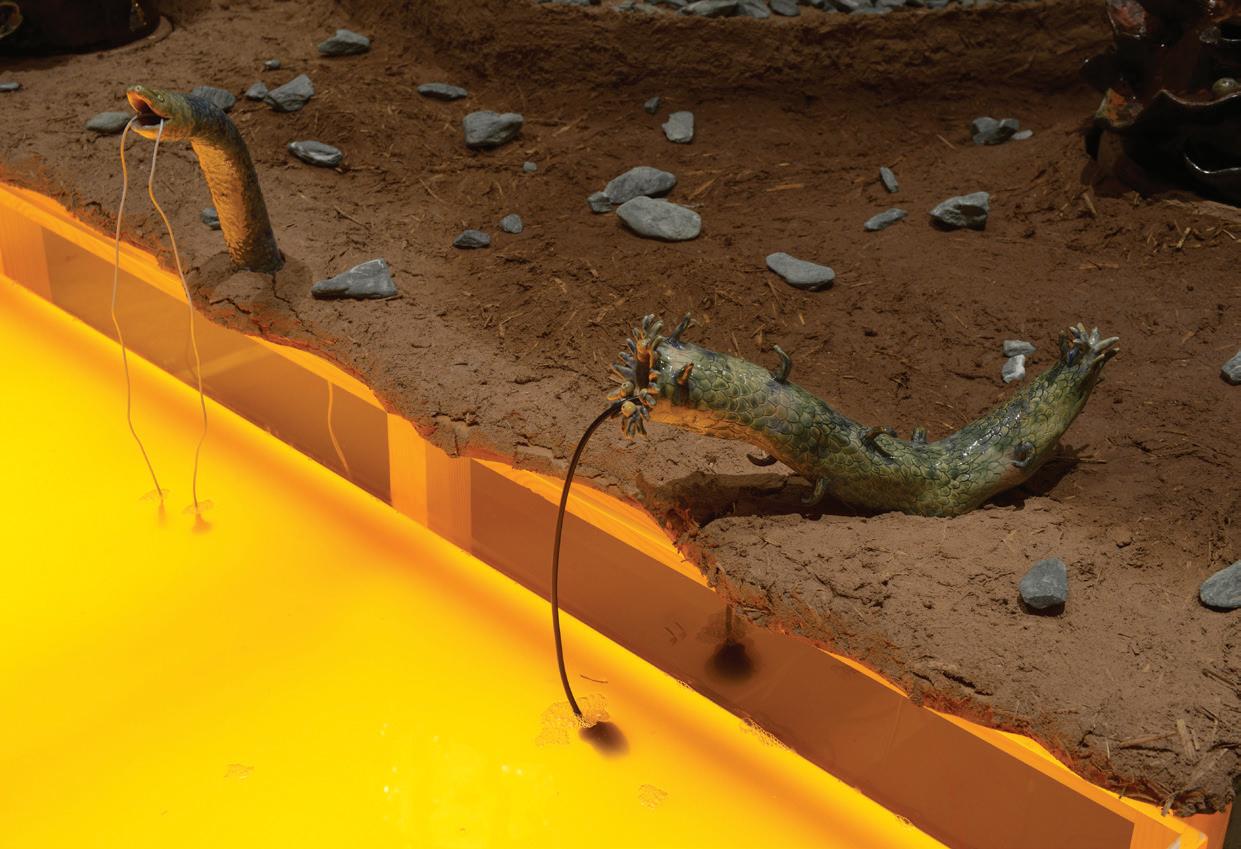
How have you approached diasporic and ancestral knowledge in your research and how has it informed your worldbuilding?
The foundations of all of this are built from a searching with and around diasporic and ancestral knowledge. It’s a desire to get closer to, to make sense of, and to follow these lively ghosts~guides in the pursuit of other ways of existing. I think of ‘ancestors’ in a broad sense, which brings me to notions of extended kin and beyond-human communities.
I consider my practice of worldbuilding as a long-term exercise in self-mythologising as a survival tactic. I use methods of fabulation, materiality and craft to mould new meanings, and fill in the gaps in my understanding of the lives of my forebears - lives ruptured by the experiences and reverberations of migration - that have formed my own. The things I make serve as documents of stories~myths~whispers. They exist as ritual offerings to my ancestral lively ghosts, as well as acting generatively as tools or
proposals for alternative cultures.
I’m interested in worldbuilding that is made up of connections, patterns, and thoughts that emanate from ancestral kin, and spiral out to beyond-human communities; a learning from other modes of survival in often unlivable, hostile environments. I look to Daoism - its philosophy and religion that has enriched my own ancestors in Singapore - and the belief that flow and change are essential features of nature. I am interested in the constant patterns in these changes, and wonder in these fractals of existence that make up the whole.
With these meditations, I view the twin foundations of these alternative spaces as the logics of my own human family, and those of beyond-human communities – particularly in relation to notions of symbiosis and multi-species interdependency. I’m interested in worlding as an accumulation of knowledge that flows through change, shapeshifts, and continuously cycles through different patterns of existence.
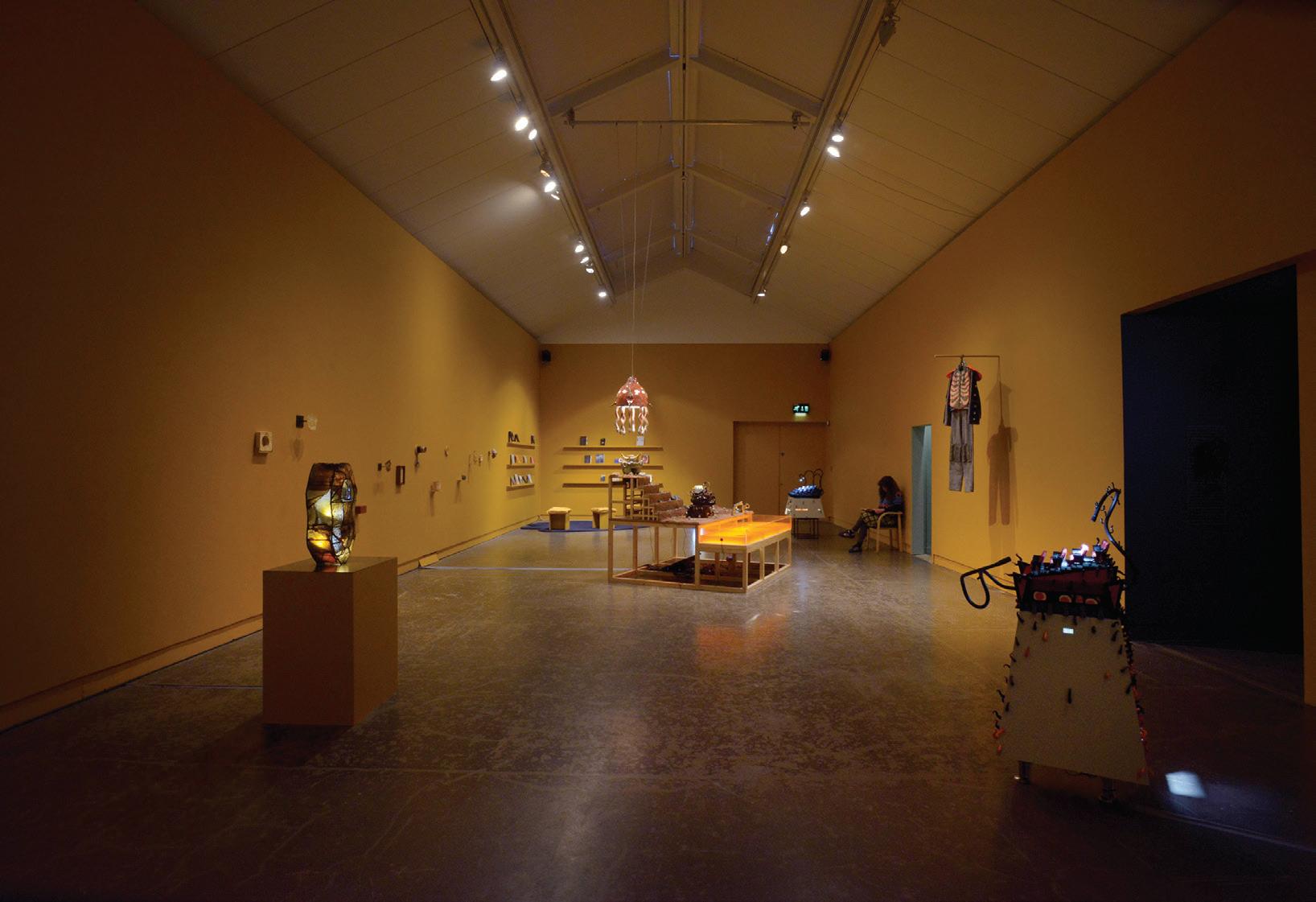
How do you think working collaboratively like this can produce different kinds of knowledge and engagement with art?
The ultimate aim within Daoism is to truly perceive the mutual interrelation of all things; the sense of the isolated individual dissolves upon identification with the greater unity. I like this as a foundation for collaborative approaches to artmaking which can accommodate multiplicity, contradiction and collectivity. Such approaches are different from a worldbuilding practice undertaken by a sole ‘creator’/singular ego. I often think about authorship… Who gets to build worlds? I am more interested in multiple voices vibrating worlds into existence, rather than the booming of one ego/god…
I consider myself first and foremost a maker, with a yearning to craft things into existence. It’s a visual language of matter, detail and colour that emphasises the world-building; a warming up of ideas and materials with my hands to create forms, friction, heat and energy. There’s an instinctive material approach to this project, and it’s what has drawn me to so many of the other amazing artists in the exhibition. I hope that the amalgamation of all of these voices offers viewers a seductive swirling of whispers, and an energy which is particular to that specific confluence of artists/artworks. My own making, however, can be a solitary, controlled activity. Conversely, in wanting to bring a body~world~beast into being, the energy of the live programme is crucial. This is where things can go way beyond my control, existing in a lively manner and in a multitude of ways; as material, as event, and as ecologies created by others. I’m excited to feel this qi swirling in the space, vibrating with connections and entwining the thoughts of so many brilliant thinkers, makers, collaborators, kin. With the gathering of these different energies, I vision the creation of a common tongue/a body of commons… For me, this sort of speculative space lays the ground for different kinds of knowledge and engagement with art. The exciting part is that I don’t know what this knowledge/engagement is. It is something beyond me; something that has been formed collectively and is continuously growing, and we’re all growing with and inside it, creating a new, dynamic culture.
A look back at:
A look back at:
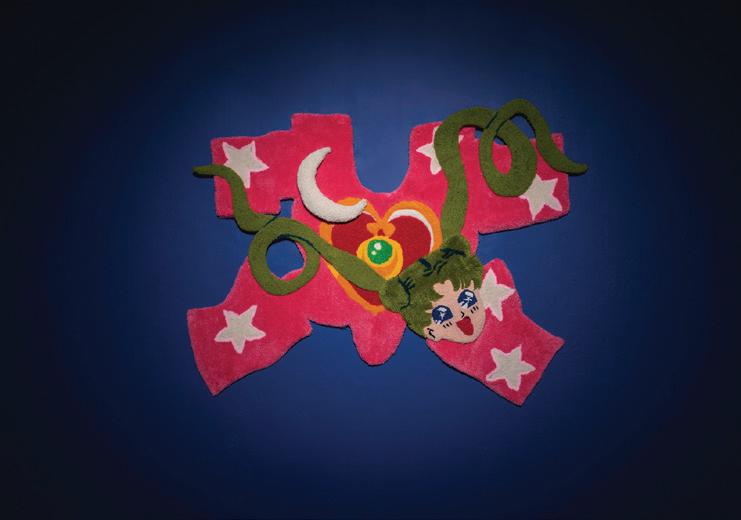
17 November — 9 December 2023 Sat 3 February — Sat 24 February 2024
Trophy Room is a presentation of past and current work exploring how identity is defined and changes, using creative competitive dog grooming as a visual language to explore these ideas through moving image, performance, sculpture and installation. Often employing humour and grotesque elements, Hlalo’s research investigates the sense of belonging and of “being in between” cultures: confused boundaries, precarious definition, origins dislocated from artefacts. Like online memetic ‘cursed images’, the work here plays with the withholding of explanation or context as a means to invoke the uncanny; the sense of arriving at an event when the awards have been announced but the acts, beings, (and/)or products they celebrate are no longer visible, aside from as inexplicable, improbable traces and records. These bizarre grooms raise questions about consent, expectation, categorisation and representation of identity. Reflecting on how they are staged, constructed and performed within social, cultural and racial categories that frame our subjectivities. These incongruous clashes and assimilations of different characters and objects play with the concept of self-recognition. Can the dogs recognise themselves after being turned into something so far from their own look and nature? Selfawareness is the ability to think about yourself as an individual and to realise that you are separate from others around you—to have a sense of self. The sense and perception of “us” and “them” is altered. Amazed, disoriented, these images make us question: What are you? Maybe these canine friends are also asking themselves: What am I?
Tulani Hlalo (b.1994, Newcastle upon Tyne) is based in Glasgow and works primarily with textiles, sculpture and video. Through costume, performativity and the absurd, her practice examines and explores ‘how identities are staged, constructed and performed within social, cultural and racial categories that inform our subjectivities.’ Her work has been exhibited across the UK and Europe. Her recent exhibitions include: Baggage Claim, Staffordshire Street (London, U.K.), The Sound of A Falling Tree, TUESDAY TO FRIDAY (Valencia, ESP), Extreme Competitive, ALMANAC Inn (Turin, IT).
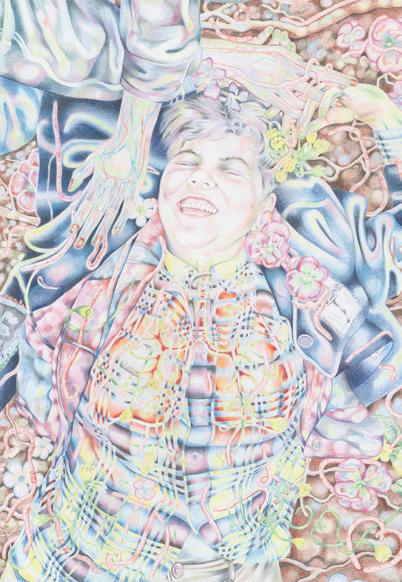
‘The Thieves’ is a collaborative exhibition by Josie Perry and Francis Jones. The show centres around a series of colour pencil drawings and a hybridform social science fiction text, presented as a publication and an audioscape. The story follows a commune living on the outskirts of a rapidly expanding neoliberal city, narrated by four individuals who have been unofficially exiled due to their refusal to conform to the city’s work standard, which rejects communality, compassion and pleasure. The narrators explain how they came to form the commune and imagine alternative means of living together.
In the audioscape, fragments of ‘the Thieves’ are voiced by Gloria Dawson, Hussein Mitha, Isaac Harris and Nat Lall, who have each contributed a text of their own to the publication, and are also visually depicted in four character portraits. These contributors were invited to join the project due to resonances between ‘the Thieves’ and their own creative practices, and the fictional characters have been loosely based on real friendships. In this sense, the project as a whole can be understood as analogous to the story’s narrative of sociality, and is a homage to our queer and creative communities in Glasgow.
Josie Perry is a Glasgow-based artist working mainly with drawing. Since 2019 she has worked on the collaborative project ‘Plasma Spring’ with Daphne Simons, which centres around a series of comics and related exhibitions fictionalising figures from art history and pop culture through an irreverent queer lens.
Francis Jones is a writer and artist from Ireland, living in London. Their pamphlet sacrificial fabric was published by SPAM in 2021. They wrote a short experimental film “I Thought I Hated U, Moon Snail” in collaboration with artist Jack Hogan for the final exhibition of the Whitney ISP, New York, which was also screened at the Colloquium Unpopular Culture at NYU in May 2023.
Last year, CCA said goodbye to Francis Mckee, who served as our Director for the last eighteen years. McKee’s transformative leadership has been instrumental in shaping CCA into a vital and distinctive institution within the arts community in Scotland and beyond.
Following the departure of Francis McKee, we are reshaping our leadership structure to encourage a more inclusive and dynamic leadership. Our new Senior Leadership team consists of Ailsa Nazir, Guillaume Coet and Sabrina Henry.
We are delighted to unveil the lineup of artists exhibiting under Sabrina’s curatorial leadership in our gallery space this year: Rae-Yen Song (Feb - May), Ashanti Harris (Jun - Aug), and Debi Banerjee (Sep - Dec). This year, we’re also excited to launch our Schools and Young People programme, which will include school visits and public workshops designed to engage children and young people with art.
We can also announce the line-up of artists who will be exhibiting in Intermedia Gallery 2024-25! Intermedia’s programme aims to support emerging artists working in Glasgow. We selected artists based on an open-call. This year, in line with our commitment to broadening our access to opportunities, Common Ground has additionally commissioned an exhibition in Intermedia to coincide with their festival in June.
The artists in 2024/25 Intermedia Gallery line-up are, Saturn Akin, Annie Metzger, Sequoia Barnes, Seif Eddine Jlassi & Mousa AlNana, Natsumi Sakomoto, Matty Rimmer, Nat Walpole, Clay AD and Robert Thomas James Mills
Francis wrote us a reflection on the arts landscape as he leaves it, and the transformative role CCA has played in Glasgow and the evolving arts scene in Scotland. In delving into the crucial role of culture in shaping the identity of the city, he contributes to the ever-present and ever-urgent call to support the arts.
As I’m leaving CCA, I’ve found myself spending more time in its archive, returning things from my desk or (unforgivably) from home. I don’t get nostalgic about archives. For me, they’ve always proved vital in establishing what we have done and, in the light of that, what we may do next. Archives are about shaping the future: that could mean taking new approaches or redefining directions. One key thing though, within the CCA archive, is the way in which the records reveal the transformation of the arts in Glasgow and Scotland.
In 1973, arts infrastructure in the city was sparse and mostly focused on history. The establishment of the Third Eye Centre redirected attention to the present, and what was unfolding in Glasgow at that very moment. Early films within our archive document staff working in candlelight during the power cuts in 1973, illuminating thriving activity across the arts – a time when exhibitions, music, poetry and literature were gaining momentum. By the early 1980s, the building blocks of a new cultural confidence were in place. In 1981, Alasdair Gray’s Lanark was launched at the Third Eye Centre and contained the, by now wellworn, observation on culture that ‘if a city hasn’t been used by an artist not even the inhabitants live there imaginatively.’
Gray understood the power of the arts to create a communal sense of identity. Films, poems, novels, plays and paintings all could reflect life in Scotland, creating imaginative spaces where ideas could be tested and debated publicly and safely. As
a nationalist, he also saw the responsibility of artists in describing a future state worth voting for (‘Work as if you live in the early days of a better nation’).
CCA archive charts the growth of an arts infrastructure over several decades, indirectly revealing the emergence of other organisations – The Print Studio, Wasps, Transmission, GOMA, Tramway, SWG3, Market Gallery, David Dale Gallery, Celine, French Street, among many others – with documents and letters quite often fleshing out the dialogues happening in the art world here.
Now, sadly, we are beginning to see a dismantling of that infrastructure as public funding shrinks. This comes at a time when recent waves of migration to Glasgow require the rethinking of cultural provision, not just the quest for decolonisation, but a renewed need to represent the widening demographic of the city. Alasdair Gray’s call for artists to respond to the city so that we can all imagine living here is more urgent than ever. Glasgow has its own stories to tell, as much as any city in the world, and it deserves to see the artists based here reflecting life around us.
COVID lockdowns taught us many lessons, but the most striking one was how much we rely on culture to see us through hard times. The films, songs, TV shows and performances that kept us going emerged from a long investment in the arts, developing the artists who created that work. Closing libraries, shutting venues and cutting support for artists and galleries will smash the mirrors that reflect our lives. In that kind of blackout, a city is meaningless. Talk of independence, identity or culture has no weight.
Politicians seem to have suffered a loss of nerve when it comes to art funding. They aren’t grasping the economic benefits or the enormous social impact of the arts in general. They also seem afraid to be seen to support the arts in hard times, as if the fractional amount of public funding it receives might be perceived as an indulgence. And yet, many of those politicians brag about Scotland’s culture and promote independence.
Beyond these ideas, there is an urgent need to reconsider what constitutes culture and to engage with the process
of hybridity that is already underway in Scottish society as the current waves of migration bring new perspectives and approaches to art. If this is to be more than tokenistic, then real change is needed across the infrastructures that underpin the presentation of work publicly.
It’s always easy to make promises around culture and issue grand statements citing wellbeing and diversity. It is harder to deliver on the ground in a convincing way. Arts organisations are used to working hard on minimum rations, but some real action would make an enormous difference. Scotland has a rich tapestry of human resources and it would be exciting to see that potential fulfilled. I want to see the better nation and the city reimagined.
Francis
McKee December 2023
We spoke to Seed Librarians Hamshya Rajkumar and Louise King about how Glasgow Seed Library is preparing for Spring.
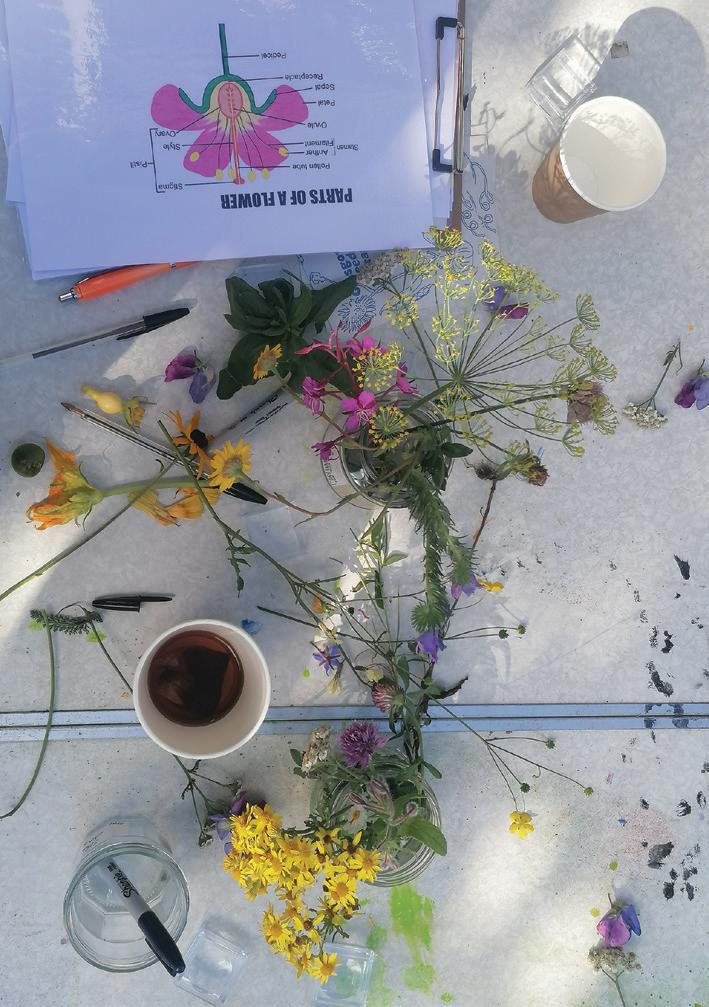
HR: GSL is a library of open pollinated, locally adapted organic seeds of vegetables & flowers. You can find the library - a little blue cabinet full of carefully packaged and labelled seeds - in the entrance of the CCA. It is open access and free for anyone who would like to borrow, grow, save and return seeds! Most seeds available for purchase are grown using chemicals, in climates and soils very different from our own in Glasgow. Saving our own seed in Glasgow makes our plants locally adapted, more resilient to the effects of climate change and culturally significant to those who grow, eat and share them.
RL: As well as getting seeds out to growers across the city, Glasgow Seed Library runs a programme of workshops to share skills in growing, harvesting and processing seed crops as well as events exploring the connections between seed keeping, social justice and the arts. We also host a researcher in residence each year. This year Tilly Nevon has joined our team, exploring how dehumanising language is applied to both human and plant migrations.
What are you excited to share with us this Spring, do you have any new events, projects, or collaborations coming up?
LK: Spring is the beginning of the growing season so we are working hard to get our seeds distributed to as many people as possible and to support people to give it a go whether they are seasoned growers or total newbies. In March we have a seedy social event where people can browse our seed collection, chat about seed saving and pick up seed starter packs designed for people who are saving seed for the first time. In April we launch the first of our “Tending to..” series of workshops with the first focussing on seedling care, as well as a workshop which will drill down on the basics of growing seed crops. We hope these events will give people the confidence and skills to save the seed we distribute this spring. Beyond this we have plans to work more closely with community gardeners across the city to develop a network of seed saving champions who can help us decentralise the work we do through integrating more seed saving into their gardening sessions.
HR: We are really trying to make the seed library more accessible to different types of urban growers. As well as our seed starter packs, we have been working on some beautiful stamps for our seed packets to indicate the suitability of each variety in our collection to windowsills and smaller space growing. I’m also excited about a new project that I am currently developing which embraces our urban ecology of trees and brownfield wildflowers by saving their seed. My hope is that it will bring awareness to urban biodiversity, local movement ecologies and attract guerilla gardeners too!
TN: Over the next six months, I’m working on a project about how dehumanising language is applied to both human and plant migrations. This spring I’ll facilitate workshops with different writers whose work touches on these topics. Inspired by thinking about the life cycle of seeds, grief and growth, and the movement of seeds, plants and people, as well as the ways in which we can rethink ideas of belonging and borders, people will be encouraged to produce creative pieces.
RL: I’m really looking forward to working more closely with Common Ground this year. We are planning some Seed to Plate events centred around the culturally significant foods from Glasgow based diaspora communities. Guest speakers, cooking demonstrations and story telling will help us explore these food cultures. I’m also excited about our
monthly study and reading groups. Both the Living Soil Lab exploring soil ecology, and Planted in this Land, a land justice study group are a way for us to delve deeper into these topics over a longer period with people who share our interests and we hope it will lead to interesting collaborative projects in the future!
How can people get involved with GSL?
There are so many ways to get involved, whether you want to attend a one off event, come to a study group or access our materials from afar! Check out the Glasgow Seed Library events page on the CCA website for more information on what we have coming up this spring and beyond, have a look at our instagram @glasgowseedlib to get an idea of our general vibe and what we have been up to and check out the Glasgow Seed Library homepage of the CCA website for a full list of resources from our various programmes.
Common Ground is a creative and social project within the CCA, comprising both a physical space and a programme of activities.
After an initial period of setting up the space, establishing partnerships, and forming connections with community members, Common Ground is excited to be in a stage of programme development, festival planning, and widening our reach.
While our core target audience are communities with refugee backgrounds, or who currently are in the asylum or refugee process, moving forward we aim to broaden our audiences and work with artists and community members of different backgrounds, regardless of their migration status. This cross-cultural approach is important for our participants to foster connections with the arts sector and will enable new and exciting collaborations.
Our plans for 2024 include the establishment of Flavour, a project revolving around the power and creativity of cooking, and the launch of our first ever Common Ground Festival.

Connecting artists and communities through food-sharing
This year we are launching Flavour, a series of food-sharing workshops and activities held in Common Ground. Cooking practices are situated as a method of connection, collaboration and story-telling in these sessions. Come along to share your favourite recipes and to learn about different food cultures while celebrating the creativity of cooking.
Individuals are invited to share their favourite recipes, extending their knowledge with the group and exhibiting their unique takes on food and cooking.
The Flavour programme will create the space for participants to share their recipes, cultural heritage and stories around food and cooking. This will take the form of food sharing events, digital recipes and a recipe book.
Our first ever edition of Common Ground Festival will be delivered in June 2024. Working with valued partners to deliver a varied programme, the festival will showcase the work of artists within our communities, featuring exhibitions, film screenings, performances and more. Coinciding with Refugee Festival Scotland and Glasgow International, the Common Ground Festival will be a celebration of the richness and diversity that various community groups bring to Glasgow.
Spanning across three days, the programme will feature an exhibition in Intermedia Gallery produced collaboratively by artists Mousa AlNana and Seif Eddine Jlassi; a newly commissioned sound performance by Cindy Islam; and a series of film screenings organised by GRAMNet.
We are working closely with our partners to produce a festival which is inclusive of a range of people with different backgrounds and experiences. These include Refugee Festival Scotland, GRAMNet, Badil Resource Centre for Palestinian Residency and Refugee Rights, Glasgow Seed Library, Cross Borders programme, and more.
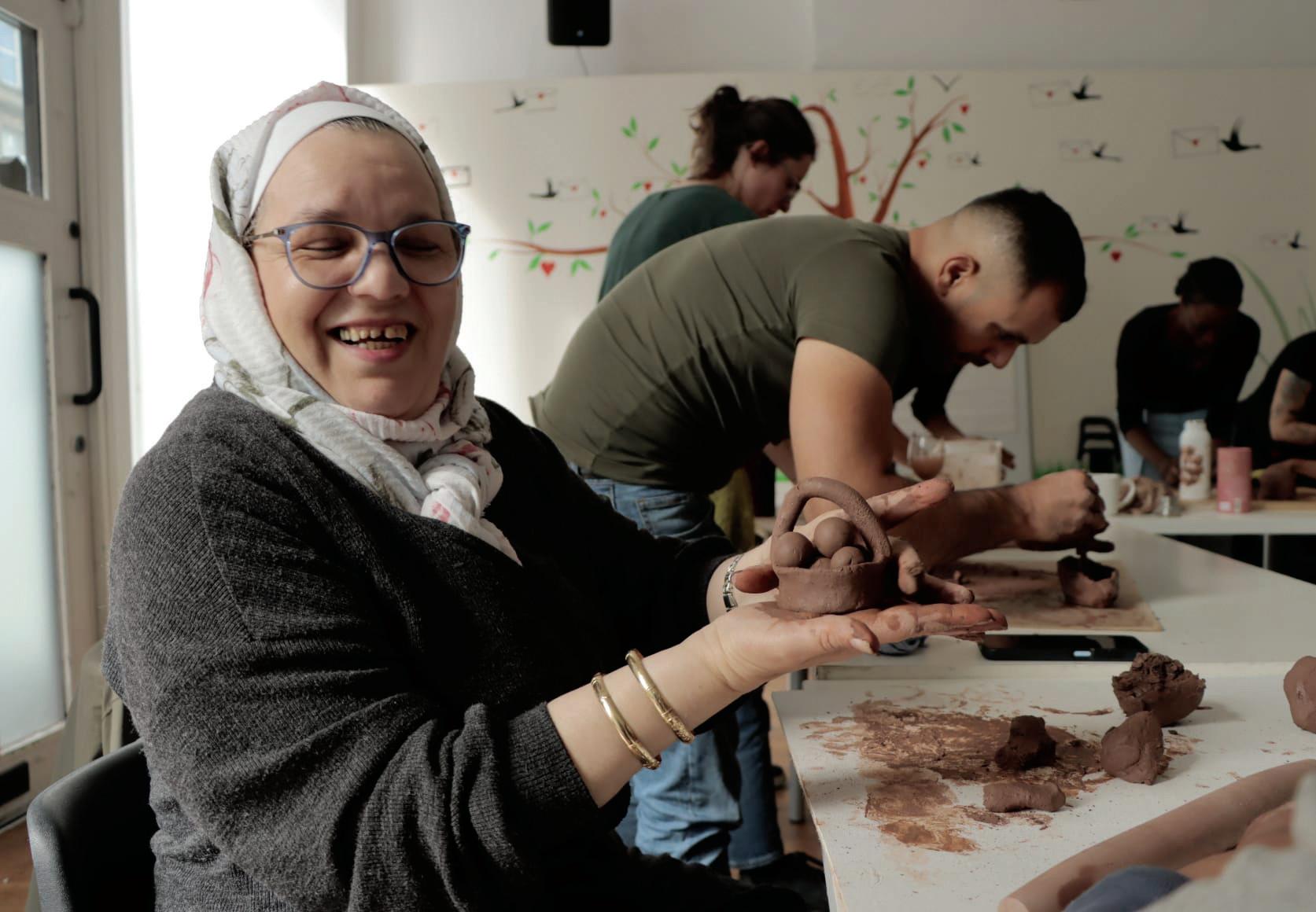
Can you tell us a little about Glasgow Short Film Festival, what’s the story of the festival and what kind of ethos to cinematic shorts do you have?
GSFF actually started life as a regular short film night at CCA called The Magic Lantern , way back in 2006 before pop-up cinema events were common in Glasgow. There was a particular focus on women filmmakers, but the organisers Penny Bartlett and Rosie Crerar were also interested in exploring that grey area between commercial film and visual art that no one can agree on a name for. Their programmes often responded to current exhibitions at CCA, or offered focuses on maverick filmmakers like Miranda July and Jane Campion.
To cut a long story …erm… “short”, they were invited to curate a short film weekend in CCA during the 2008 edition of Glasgow Film Festival, and the Short Film Festival developed from there. Although it has grown and changed beyond recognition, I think we’ve retained their spirit of inclusive exploration of different forms and cinematic experiments, without losing sight of either the film industry or the art world.
Could you tell us a little about programming short films and the selection process?
We receive 4,000 submitted films each year — our Scottish and International competitions are drawn exclusively from these submissions, along with regular comedy, horror and family strands. In addition, we stage filmmaker focuses and curated strands, which often combine retrospective or archive work with submissions and other new films we have seen at international events.
The 4,000 films are viewed by our team of pre-selectors. Most of the films are viewed at least twice, and where the viewers’ responses diverge significantly, films are reviewed by the whole team
and discussed at regular group meetings. Shortlists are drawn up for both Scottish and international competitions, and a smaller committee watches all of them before discussing them in depth over several sessions. We were able to do this in person for the first time since 2020 this year - it was a much more meaningful and satisfying process than a Zoom meeting. Genuine consensus was more easily established and we even found quick agreement on programme groupings and running orders, a task we usually procrastinate over for days.
In making the competition selection we are looking for integrity - films that explore the distinct possibilities of the short form, rather than serving as a proof of concept for a feature - and originality, by which I mean some experimentation with form or storytelling. Factors of representation, duration and previous exposure come into play, and we also seek to avoid too much repetition of themes or forms across the selection. We are less concerned with technical prowess than with ambition, playfulness and fresh ideas.
do you think Glasgow Short Film Festival is so important to Scotland’s filmmaking culture?
Since the earliest days of the festival, we have aimed to showcase emerging Scottish film talent in an international context. That’s why we established an international competition a couple of years before introducing a second competition for Scottish filmmakers, and why we have worked hard to form relationships with other festivals overseas and attract as many filmmakers and industry representatives as possible to Scotland each March. We have hosted programmers from festivals of the calibre of Toronto, Sundance, Clermont-Ferrand, Venice and Locarno. Scottish filmmaking is dependent on international collaboration, both in terms of resources and in developing a cinematic language that can travel, that is not insular or blinkered. It’s always been our ambition to create a friendly, inclusive environment where critical and curious conversations can take place and new connections can form.
At the same time, our connections afford us the opportunity to showcase Scottish filmmakers internationally. We’ve collaborated with festivals in Austria, Brazil, China, France, Germany, Ireland, the Netherlands, Poland, Spain, Sweden, Switzerland, South Korea and many other countries to bring Scottish film to new audiences.
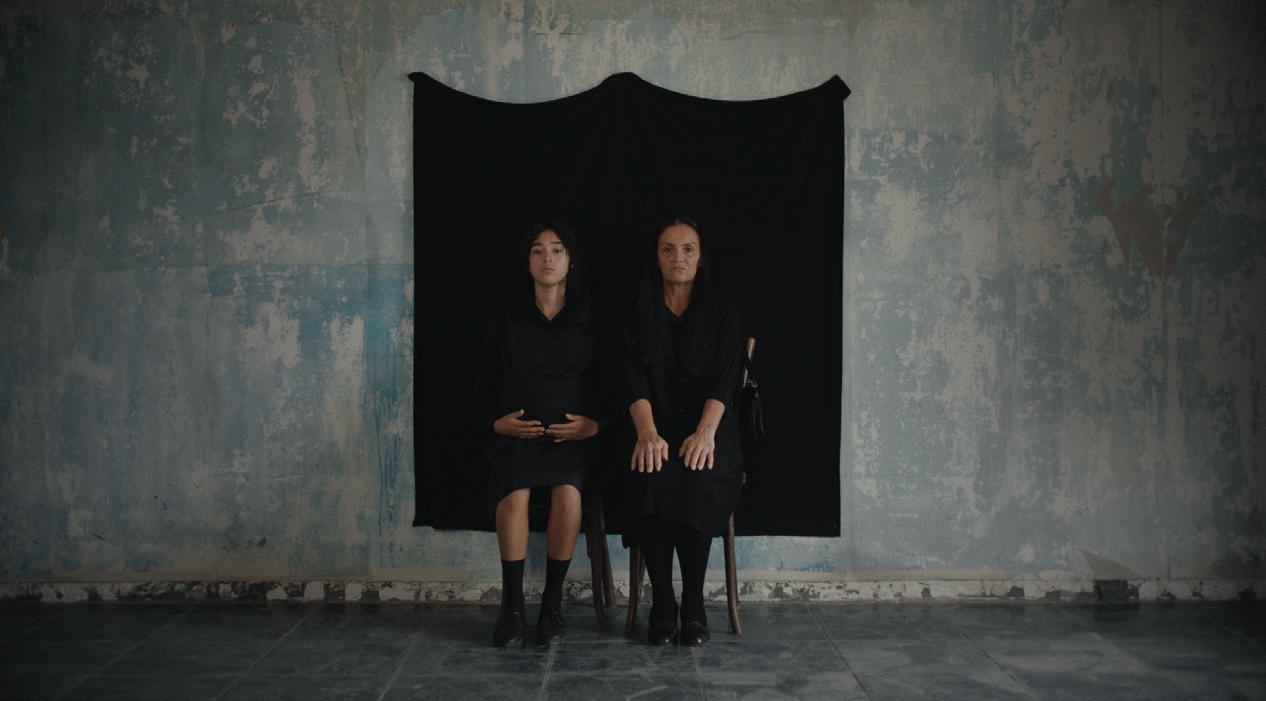
Can you tell us a bit about CinemaAttic? What are your goals when it comes to screening independent international cinema in Scotland?
CinemaAttic was established in 2008 in Edinburgh as an arts and culture blog to provide a platform for thoughts and ideas about independent cinema. The name derives from its first venue, a secret loft located in the heart of Edinburgh that was converted into a cinema to host underground cultural events. Today, CinemaAttic has flourished into one of Scotland’s key players in the film exhibition scene, delivering our events strategically with some of the most prominent Scottish festivals and organisations.
Our goal is to keep independent cinema alive with enhanced film experiences and a strong social approach that allows us to bring these films to specialised Scottish audiences across the country with a specific focus on Ibero-American cinema.
What about the programme you have planned for this spring?
Brasil: A Slow Film Festival is a brand-new festival we created with six screenings across six months that seek to show the best of contemporary Brazilian cinema in Scotland.
ADRIFT’s third edition returns with a thrilling six-week film season celebrating contemporary and rare films showcasing the best of world cinema. The programme will include workshops, special events and some occasional surprises.
You also run the Catalan Film Festival, could you tell us a little about the festival, and any stand-outs from that programme?
We are delighted to present the ninth edition of the highly-anticipated Catalan Film Festival coming to cinemas across Scotland from March 20th 2024. The festival was created to celebrate the uniqueness of Catalan culture in Scotland and to showcase Catalan auteurs as well as upcoming new talent. We secure the hottest award-winning Catalan films, both features and shorts, with many making their debut UK & Scottish premieres. The previous year included One Year, One Night by Isaki Lacuesta and My Emptiness and I by Adrián Silvestre, and the winner of the Berlinale Golden Bear award, Carla Simón’s amazing Alcarràs
This year is no different, we will be screening La Imatge Permanent by graduate director Laura Ferrés who won the Golden Spike for Best Film at the 68th Valladolid International Film Festival, one of the most prestigious festivals in Europe. We’ll also be screening Creatura (2023) by award-winning director Elena Martín, a film that explores a sexual awakening which causes a woman to reconsider her past relationships.
The Catalan Film Festival is split between in-person screenings and a special curated online programme. Throughout the festival audiences can also engage in workshops, Q&As with invited filmmakers, gastronomy screenings and more. The full programme will be announced in the coming weeks!
Could you tell us a little about the ideas behind the Collective Dreaming project, what were your goals and how have you approached it?
Collective Dreaming emerged from our lived experiences as Eastern Europeans in Scotland. Here (and the collective West more broadly), Eastern Europe faces representational and discursive gaps, especially when thinking about such topics as colonialism. Undoubtedly, the strongest point in solidifying this position was the full-scale invasion of Ukraine in 2022. With its brutality and horror in situ, the invasion also elucidated the difference between memory and knowledge. Stories told by our parents and grandparents about exile to Siberia, the internalised need not to stand out and so many intuitively felt silences (untold stories) resurfaced. While (understandably) for the surroundings the invasion was seen through their knowledge (political, historical, economic or otherwise). The binary is always a simplification but this was the point from which we jumped off, attempted to find and embrace ambiguities and weave the personal into a broader tapestry.
Residing in Scotland, we became more familiar with self-organisation and liberatory practices. The notion of national self-determination expanded into other realms and an emphasis on independence became an emphasis on inter dependence (or even intra dependence as per Barad). Wishing to tie in these contexts and thus searching for global alliances, we wanted to acknowledge our White privilege as Eastern Europeans while also understanding that the region is not quite part of the Global North nor Global South. Bringing to the fore Ukrainian and Lithuanian contexts in a discussion about Eastern Europe is perhaps a gesture of resistance as well, especially given that for a long time Poland, the Balkans and Russia have been the dominating ones in the Eastern European canon of art. Filmic conversations between Scottish, Ukrainian and Lithuanian moving images and interviews with cultural workers related to the region were the approaches of our choice for what became, as Milda called it, a scrapbook research.
focus the screenings on this year?
This year, the two topics we will weave the programme around will be language and environment. We take language in a broader sense, understanding it as the various means of communication. This focus is a continuation of the conversation we had with Agnė Jokšė, who suggested a way to make the Lithuanian language gender-neutral (something that is possible in the English language but traditionally not so much in Lithuanian). A strong feminist thread is emerging as well, which in relation to language can be understood as the way that knowledge circulates from other imperial languages into not-so-widely used ones. With the focus on the environment, we wish to draw attention to the capitalist fragmentation of political, economic, historical and environmental issues and the resource dependencies between Russia and other regions.
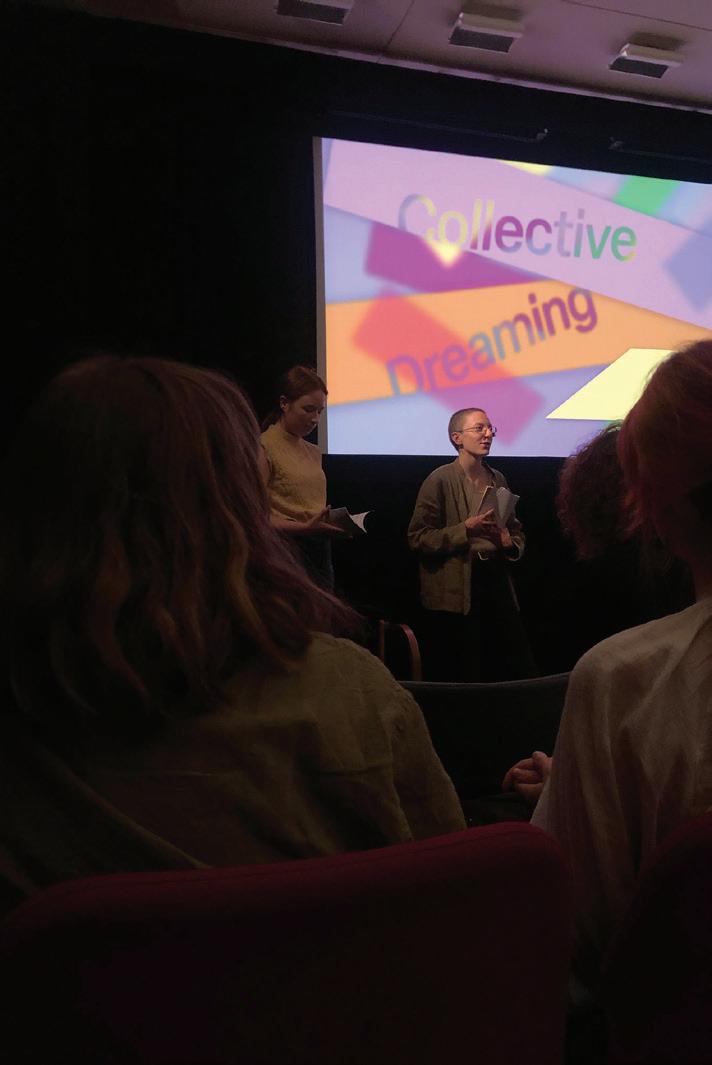
How has programming the project this year changed, did you learn anything from last year’s screenings and experience?
After reflecting on the first edition of this programme, we realised that we both understood the dreaming part of our title a little differently. Milda focused on imagination, while Julija thought of dreaming when sleeping. This realisation prompted us to acknowledge the many sides of dreaming in our programming, as well as encouraged us to look for ways to expand on and intertwine different meanings of dreaming . The final screening last year was followed by informal conversations and some nibbles, showing us that creating space for more informal exchanges was as important as discursive events. From there, ideas emerged to expand this year’s programme to include both screenings and workshops, with more opportunities for sharing and creating together.
We’re spotlighting objects from our extensive CCA archive, which is full of treasures stretching back to the opening of the building as the Third Eye Centre in 1975. The archive showcases Glasgow’s artistic history and acts as a testament to how such a vibrant art scene grew in the city.
Khaled Hourani
4 April — 18 May 2014
Khaled Hourani held his first retrospective at CCA in 2014, featuring installation and conceptual work ranging from the 2000s. Hourani’s work addresses Palestinian identity, politics, and cultural expression. He co-founded the International Academy of Art in Palestine, where he made history by bringing an original Picasso painting, “Buste de Femme, 1943,” to the West Bank for the first time.

Photography by Alan Dimmick.
The figurines faced two video monitors, showing footage from the Assaf’s final winning performance and Palestinians gathered in town squares to watch it on large screens. Hourani spoke on the phenomenon: “it showed how much the Palestinian people needed an idol, and spoke of their desire to find a new hero; only this time, the hero was [one] of them.” 1
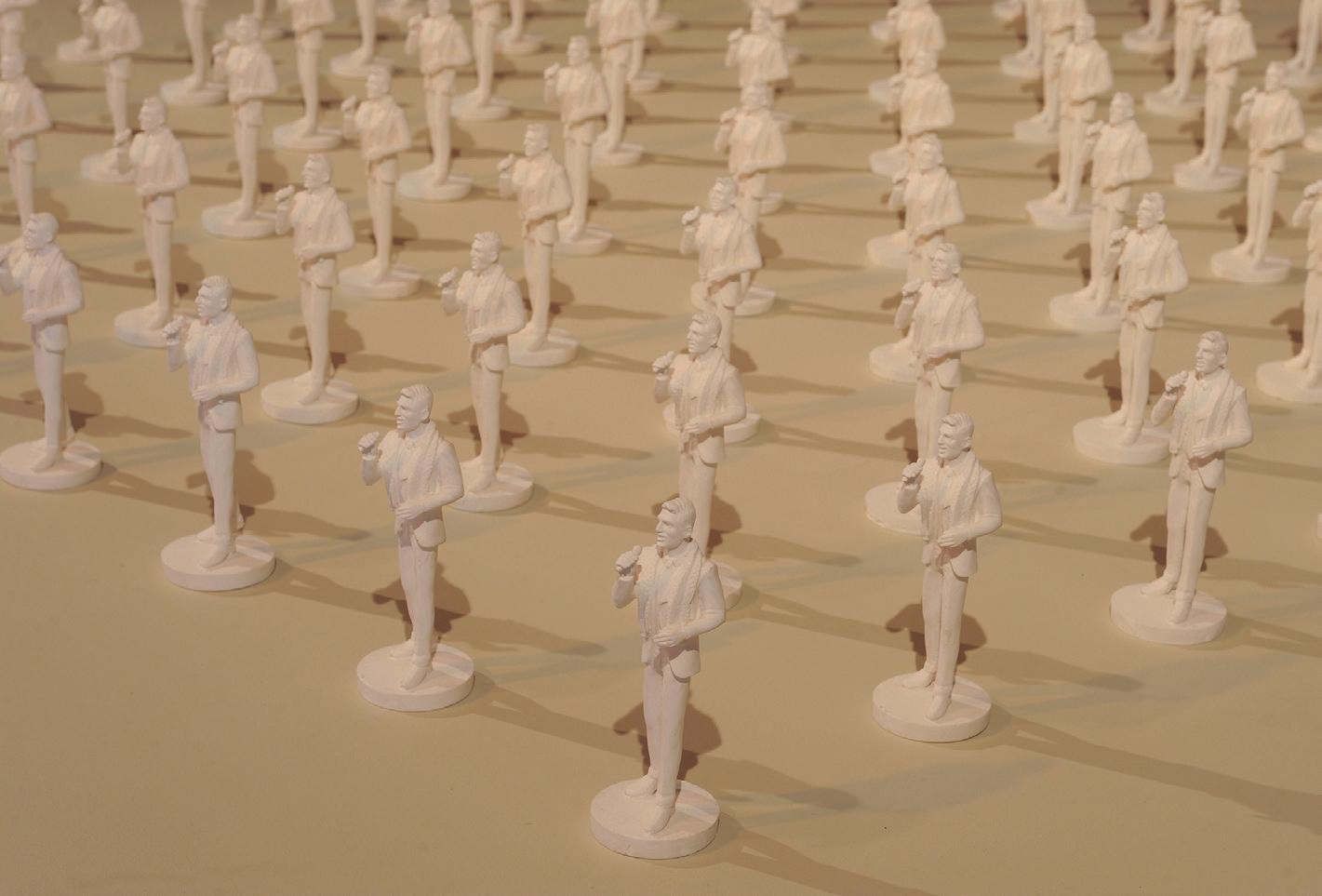
CCA Archive presents a timeline of the Third Eye Centre (1975-1991) and CCA (1992-the present). The archive chronicles the city’s artistic history, and includes film, photographs. articles, letters and other ephemera. The archive is completely free to access, just contact our dedicated archivist on archive@cca-glasgow.com to arrange a visit.
Hourani contributed one new work to the show, “Arab Idol”, a collection of a hundred figurines representing Palestinian singer Mohammad Assaf, winner in 2013 of the Arab version of Pop Idol.
1 “Palestinian Idol” by Inaya Hodeib, REORIENT magazine, April 14, 2014.

You’ll find all event details on our website’s “What’s On” page or pop in to chat to our friendly reception staff, who can also be reached on 0141 352 4900.
Stay informed of every event and exhibition on our social media:
Twitter: CCA_Glasgow
Instagram: CCA_Glasgow
Facebook: CCA Glasgow
Centre for Contemporary Arts 350 Sauchiehall St, Glasgow G2 3JD
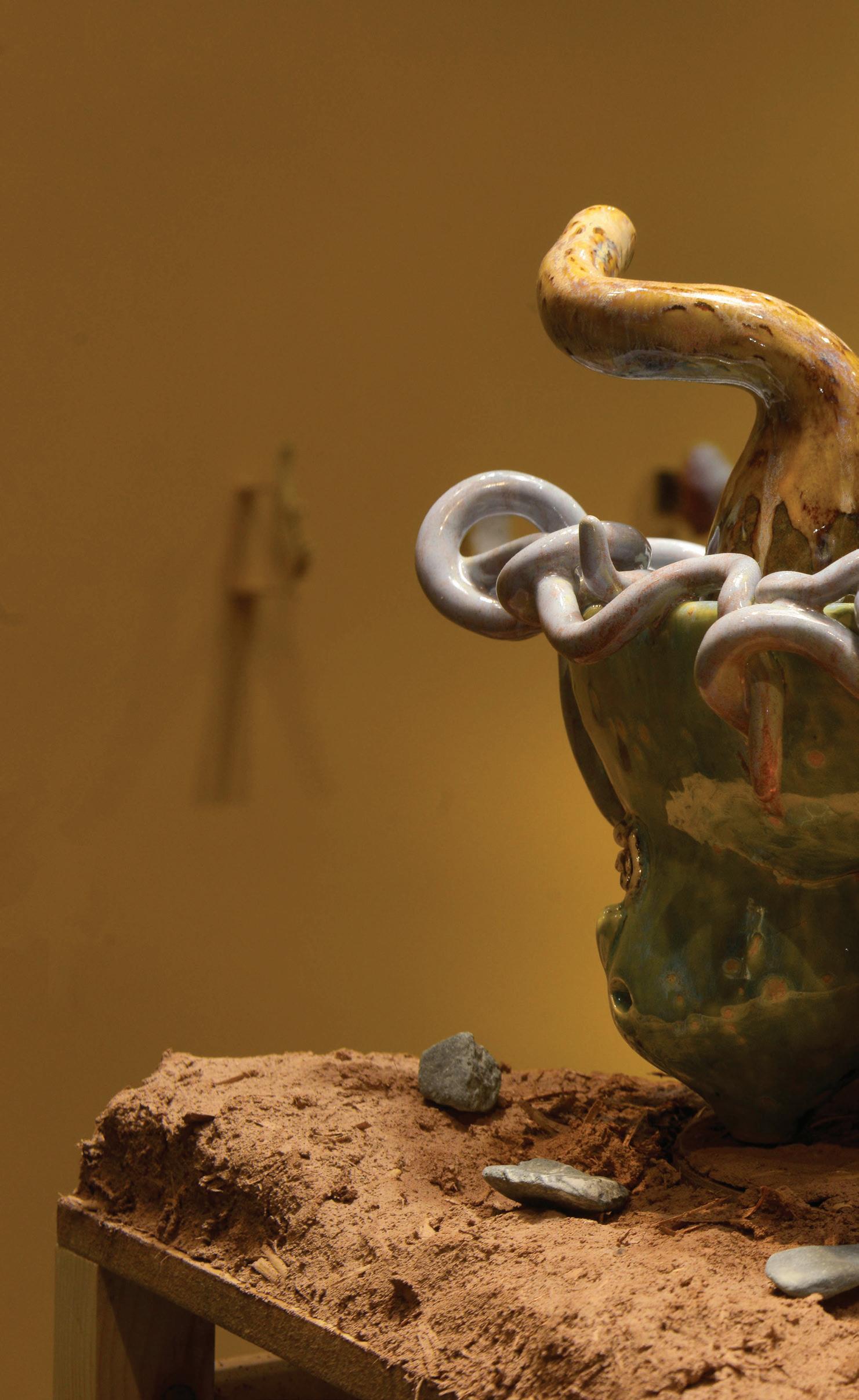

CCA is a company limited by guarantee with charitable status. Registered Company No: SC140944.
Registered Scottish Charity No: SC020734.